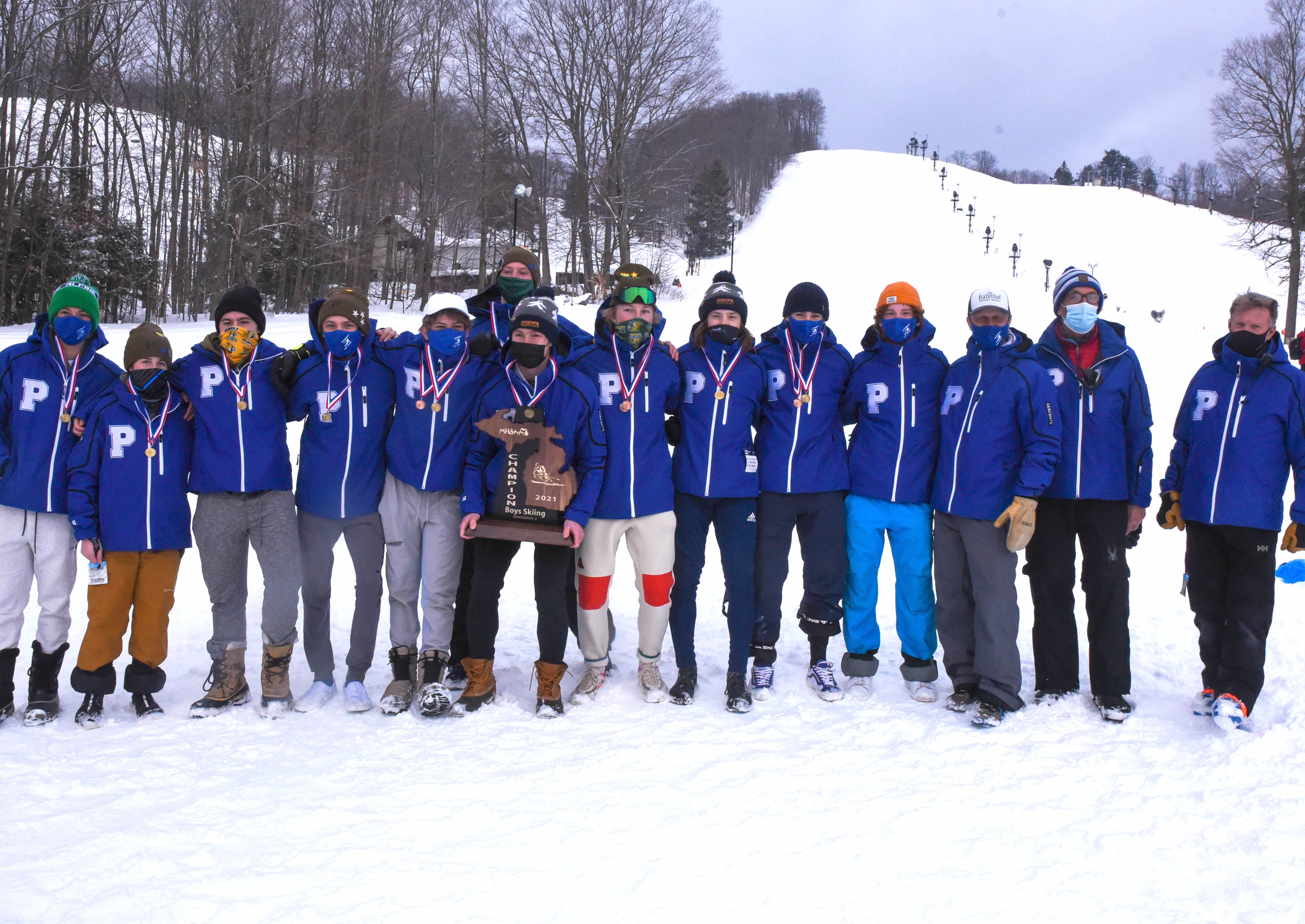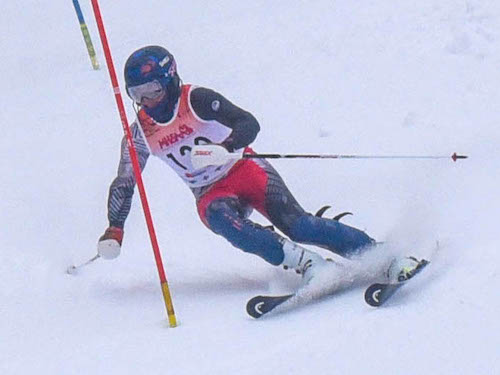
Petoskey Overtakes Rival to Repeat as D2 Champ
February 22, 2021
By Andrew Rosenthal
Special for Second Half
HARBOR SPRINGS — The streak has started again.
Petoskey beat out Great North Alpine for the Division 2 skiing title at Boyne Highlands Resort on Monday after missing out on the Regional title to GNA last week.
The Northmen went back-to-back to make it 10 championships out of the last 11 years. The only team to win a Division 2 title during that run was Great North Alpine in 2019, the co-op program combining athletes from Elk Rapids, Traverse City St. Francis and Grand Traverse Academy.
Monday’s win also made the Northmen the third team in the Big North Conference to take home a Finals championship trophy this winter. Traverse City West’s boys and Traverse City Central’s girls won titles just across the street at Nubs Nob in the Division 1 Finals.
Ben Crockett, who coaches the Petoskey boys, wasn't really surprised at that given the reputation of BNC schools producing quality skiers.
"We're getting a lot more challenges from schools in the Grand Rapids and Detroit areas," Crockett said. "To stay on top, we're going to have to keep working hard to be able to stay in the position that we're in, but we're feeling pretty good that we've got such good strength locally here."
Both Petoskey and GNA had a bevy of all-state finishers Monday.
For Petoskey in the giant slalom, Anders McCarthy was the leader taking third (1:02.13), Wyatt Mattson took fifth (1:02.86), and William Goelz placed 12th for second-team all-state (1:04.02). McCarthy (fifth) and Goelz (10th) finished with all-state honors in the slalom, Nolan Walkerdine (11th) and Mattson (13th) earning second-team all-state. Michael Iverson finished 21st in slalom to narrowly miss making the second team.
Sully Husband was the only Great North Alpine skier to medal in the morning session, taking fourth in the GS with a time of 1:02.41. Ayden Ferris (13th), Shane Pilate (15th) and Corbin Murphy (19th) each earned second-team all-state nods. Husband doubled up in the afternoon, finishing sixth in slalom, and Ferris joined him at the podium in seventh.
Husband attributed the team's success to getting four solid runs in. He said that's also what led to GNA's Regional title win over Petoskey.
"I'm kind of happy that we got a nice finish," Husband said. "We got second place; kind of stinks that we didn't get first place. But you know, I'm happy that we made it down in one piece because that's really the challenge at the end of the day."
Ben Ferris, who coaches GNA, said it's always nice to bring hardware back. When a co-op school wins a Finals trophy, a duplicate trophy goes to each school that is a part of the co-op.
"It's really about who skis the cleanest all day long and brings things together," Ferris said. "D2 has a really strong skier population anyways, so anytime you get somewhere up and you can make (it) in that top three it's a pretty successful season."
 Crockett said 10 titles in 11 years doesn't take away from the years the Northmen won eight straight. If anything, he said it's a good thing to have several teams knocking on the door.
Crockett said 10 titles in 11 years doesn't take away from the years the Northmen won eight straight. If anything, he said it's a good thing to have several teams knocking on the door.
Pontiac Notre Dame Prep (72 points) finished just behind Great North Alpine (71 points), narrowly missing a first top-two Finals finish in program history.
"We want a sport where we have competitive teams and where we're all pushing each other to be better athletes and better competitors," Crockett said. "I think the more competition that we have, and the closer it is, the more the win means."
Jack Lintol led the Fighting Irish in their third-place finish, taking home a title from the morning giant slalom session with a time of 1:01.35. Reed Heathman, who competed individually from Houghton, took second in that same event.
But then Heathman, a junior, came back and beat out Lintol in the slalom for the other individual title of the day. He had the fastest time on his first run with a 39.17 and built on that time with the fastest on the second run as well, a 41.95 to win with 1:21.12.
Heathman took third in GS last year — and said his goal going into last offseason was to improve on that.
“I’m glad to see that was accomplished. I’m happy,” Heathman said. “I didn’t know that I was going to win, but that was the ultimate goal. I knew that competition was going be tough, so I had my work cut out for me.
“I felt in control the whole time. I stayed forward, I stayed ahead of it, it felt good.”
Outside of Petoskey or Great North Alpine, the only other skiers to medal in both GS and slalom were Harbor Springs' Conner Truman and Quincy Thayer, a Frankfort student who competes for Benzie Central. Thayer took seventh in GS with a time of 1:03.31 and eighth in slalom at 1:26.06, while Truman was fourth in slalom at 1:23.40 and ninth in GS with a 1:03.80.
PHOTOS: (Top) Petoskey celebrates its 10th Division 2 championship in 11 seasons Monday. (Middle) Houghton’s Reed Heathman races toward his championship in the slalom. (Click for more from Sports in Motion.)

- Boys Swim & Dive
- Wrestling
- Girls Swim & Dive
- Competitive Cheer
- Girls Bowling
- Girls Skiing
- Boys Skiing
- Girls Basketball
- Boys Basketball
- Boys Bowling
- Gymnastics
- Ice Hockey
- MHSAA News
MHSAA Winter Sports Start with Extended Basketball Schedules, New Wrestling Weights
By
Geoff Kimmerly
MHSAA.com senior editor
December 13, 2022
The addition of two games to basketball regular-season schedules and a new series of wrestling weight classes are likely the most noticeable Winter 2022-23 changes as an estimated 65,000 athletes statewide take part in 13 sports for which the Michigan High School Athletic Association sponsors postseason tournaments.
Girls gymnastics and boys ice hockey teams were able to begin practice Oct. 31, with the rest of those sports beginning in November – including also girls and boys basketball, girls and boys bowling, girls competitive cheer, girls and boys skiing, Upper Peninsula girls and boys and Lower Peninsula boys swimming & diving, and girls and boys wrestling.
A variety of changes are in effect for winter sports this season, including a several that will be noteworthy and noticeable to teams and spectators alike.
Basketball remains the most-participated winter sport for MHSAA member schools with 33,000 athletes taking part last season, and for the first time, basketball teams may play up to 22 regular-season games. This increase from the previous 20-game schedule allows more games for teams at every high school level – varsity, junior varsity and freshman.
Another significant change has been made in wrestling, as the majority of boys wrestling weight classes have been adjusted for this season in anticipation of a national change coming in 2023-24. The updated boys weight classes are 106, 113, 120, 126, 132, 138, 144, 150, 157, 165, 175, 190, 215 and 285 pounds. Only 215 and 285 remain from the previous lineup. There is also one change to girls weight classes, with the 255 class replaced by 235 to also align with national high school standards.
A series of notable changes will affect how competition takes place at the MHSAA Tournament levels. In hockey, in addition to a new classification process that spread cooperative and single-school programs evenly throughout the three playoff divisions, the MHSAA Tournament will employ two changes. The Michigan Power Ratings (MPR) will be used to seed the entire Regional round, not just the top two teams, and prior to the start of Semifinals, a seeding committee will reseed the remaining four teams in each division with the top seed in each then facing the No. 4 seed, and the No. 2 seed facing No. 3.
Bowling also will see an MHSAA Tournament change, as the Team Regional format will mirror the long-standing Team Final with teams playing eight Baker games and two regular games at both levels. And as also applied during the fall girls season, there is a new qualification process for divers seeking to advance to Lower Peninsula Boys Swimming & Diving Finals. In each of the three divisions, each Regional will be guaranteed 10 qualifiers for the Finals, with six more “floating” qualifier entries to be distributed to the Regionals that have one of the previous year’s top six returning Finals divers in their fields. If a team changes division from the previous season, any floating top-six spots are added to the six already allowed in the school’s new division.
A gymnastics rules change provides an opportunity for additional scoring during the floor exercise. A dance passage requirement was added in place of the former dance series requirement to encourage creativity and a more artistic use of dance. The dance passage requires gymnasts to include two Group 1 elements – one a leap with legs in cross or side split position, the other a superior element.
In competitive cheer, the penalty for going over the time limit in each round was adjusted to one penalty point for every second over the time limit, not to exceed 15 points. The new time limit rule is more lenient than the past penalty, which subtracted points based on ranges of time over the limit.
The 2022-23 Winter campaign culminates with postseason tournaments, as the championship schedule begins with the Upper Peninsula Girls & Boys Swimming & Diving Finals on Feb. 18 and wraps up with the Boys Basketball Finals on March 25. Here is a complete list of winter tournament dates:
Boys Basketball
Districts – March 6, 8, 10
Regionals – March 13, 15
Quarterfinals – March 21
Semifinals – March 23-24
Finals – March 25
Girls Basketball
Districts – Feb. 27, March 1, 3
Regionals – March 7, 9
Quarterfinals – March 14
Semifinals – March 16-17
Finals – March 18
Bowling
Regionals – Feb. 24-25
Finals – March 3-4
Competitive Cheer
District – Feb. 17-18
Regionals – Feb. 25
Finals – March 2-3
Gymnastics
Regionals – March 4
Finals – March 10-11
Ice Hockey
Regionals – Feb. 20-March 1
Quarterfinals – March 4
Semifinals – March 9-10
Finals – March 11
Skiing
Regionals – Feb. 13-17
Finals – Feb. 27
Swimming & Diving
Upper Peninsula Girls/Boys Finals – Feb. 18
Lower Peninsula Boys Diving Regionals – March 2
Lower Peninsula Boys Finals – March 10-11
Wrestling – Team
Districts – Feb. 8-9
Regionals – Feb. 15
Finals – Feb. 24-25
Wrestling – Individual
Districts – Feb. 11
Regionals – Feb. 18
Finals – March 3-4
The MHSAA is a private, not-for-profit corporation of voluntary membership by more than 1,500 public and private senior high schools and junior high/middle schools which exists to develop common rules for athletic eligibility and competition. No government funds or tax dollars support the MHSAA, which was the first such association nationally to not accept membership dues or tournament entry fees from schools. Member schools which enforce these rules are permitted to participate in MHSAA tournaments, which attract more than 1.3 million spectators each year.

